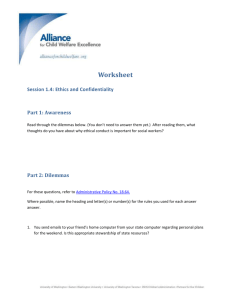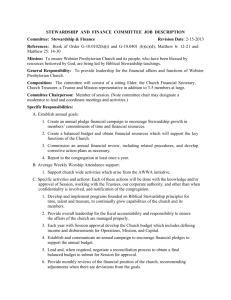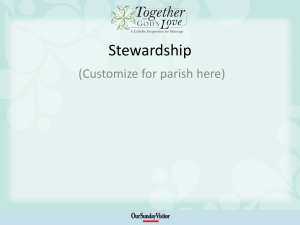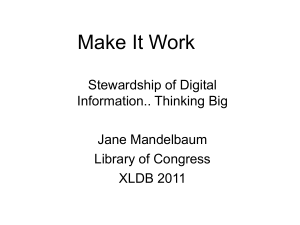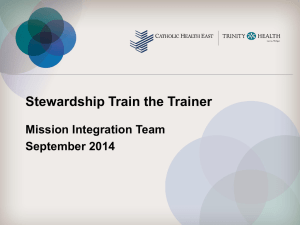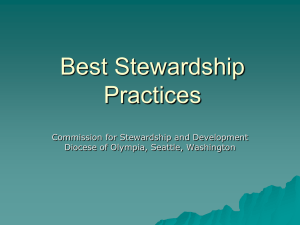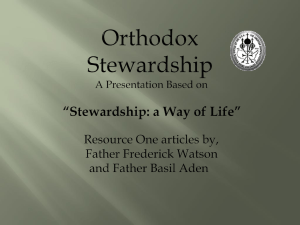Ch. 18 MS-Word - Maine Legislature
advertisement
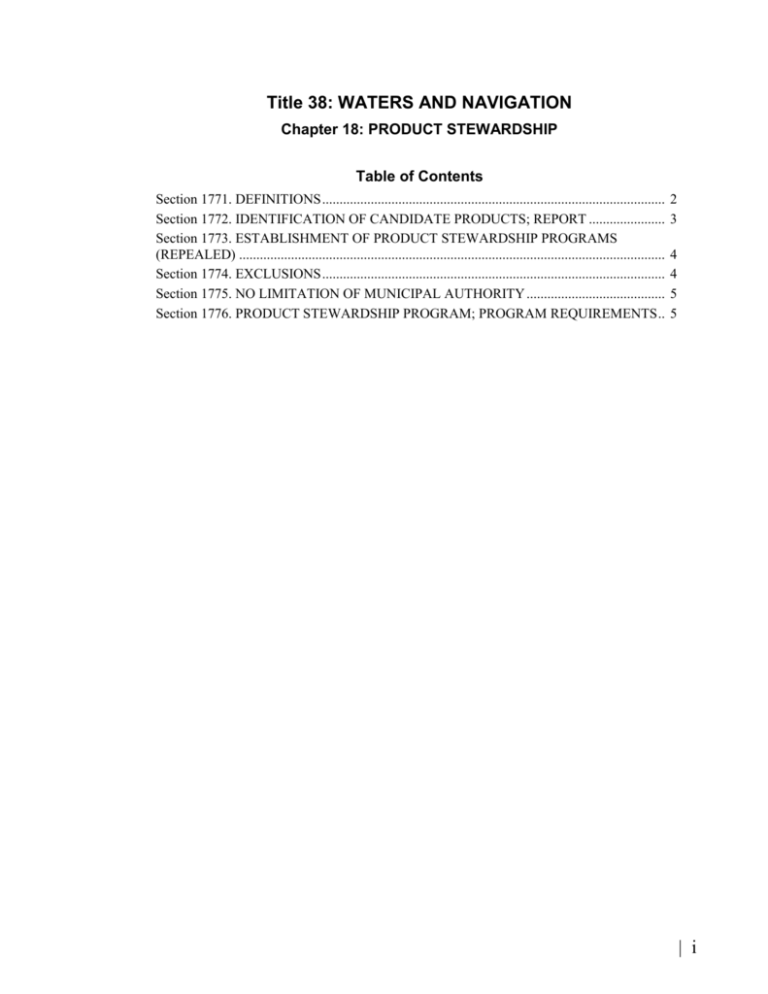
Title 38: WATERS AND NAVIGATION Chapter 18: PRODUCT STEWARDSHIP Table of Contents Section 1771. DEFINITIONS ................................................................................................... Section 1772. IDENTIFICATION OF CANDIDATE PRODUCTS; REPORT ...................... Section 1773. ESTABLISHMENT OF PRODUCT STEWARDSHIP PROGRAMS (REPEALED) ........................................................................................................................... Section 1774. EXCLUSIONS ................................................................................................... Section 1775. NO LIMITATION OF MUNICIPAL AUTHORITY ........................................ Section 1776. PRODUCT STEWARDSHIP PROGRAM; PROGRAM REQUIREMENTS .. 2 3 4 4 5 5 | i Maine Revised Statutes Title 38: WATERS AND NAVIGATION Chapter 18: PRODUCT STEWARDSHIP §1771. DEFINITIONS As used in this chapter, unless the context otherwise indicates, the following terms have the following meanings. [2009, c. 516, §1 (NEW).] 1. Brand. "Brand" means a name, symbol, word or mark that identifies a product, rather than its components, and attributes the product to the owner of the brand. [ 2009, c. 516, §1 (NEW) .] 1-A. Covered entity. "Covered entity" means a household in this State, a business or nonprofit organization in this State exempt from taxation under the United States Internal Revenue Code of 1986, Section 501(c)(3) that employs 100 or fewer individuals, an elementary school in this State or a secondary school in this State. [ 2013, c. 315, §3 (NEW) .] 2. Producer. "Producer" means a person that: A. Has legal ownership of the brand of a product sold in or into the State; [2009, c. 516, §1 (NEW).] B. Imports a product branded by a person that meets the requirements of paragraph A and has no physical presence in the United States; or [2009, c. 516, §1 (NEW).] C. Sells a product in the State at wholesale or retail, does not have legal ownership of the brand of the product and elects to fulfill the responsibilities of the producer for that product. [2009, c. 516, §1 (NEW).] [ 2009, c. 516, §1 (NEW) .] 3. Product. "Product" means an item intended for sale within the State that is identified pursuant to section 1772 as appropriate for a product stewardship program. [ 2009, c. 516, §1 (NEW) .] 4. Product category. "Product category" means a group of similar products designated pursuant to section 1772 for the purpose of establishing product stewardship programs. [ 2009, c. 516, §1 (NEW) .] 5. Product stewardship. "Product stewardship" means a producer's taking responsibility for managing and reducing the life-cycle impacts of the producer's product, from product design to end-of-life management. [ 2009, c. 516, §1 (NEW) .] 6. Product stewardship program. "Product stewardship program" means a program financed and either managed or provided by producers individually or collectively that includes, but is not limited to, the collection, transportation, reuse and recycling or disposal, or both, of unwanted products. "Product Generated 12.11.2015 | 2 MRS Title 38, Chapter 18: PRODUCT STEWARDSHIP stewardship program" includes a program financed through an assessment paid by the producers to a stewardship organization. [ 2011, c. 206, §33 (AMD) .] 7. Recycling. "Recycling" means the transforming or remanufacturing of an unwanted product or the unwanted product's components and by-products into usable or marketable materials. "Recycling" does not include landfill disposal, incineration or energy recovery or energy generation by means of combusting unwanted products, components and by-products with or without other waste. [ 2009, c. 516, §1 (NEW) .] 8. Reuse. "Reuse" means a change in ownership of a product or component in a product for use in the same manner and purpose for which it was originally produced. [ 2009, c. 516, §1 (NEW) .] 8-A. Stewardship organization. "Stewardship organization" means a corporation, nonprofit organization or other legal entity created by a producer or group of producers to implement a product stewardship program. [ 2011, c. 206, §34 (NEW) .] 9. Unwanted product. "Unwanted product" means a product that is no longer wanted by its owner or that has been abandoned or discarded or is intended to be discarded by its owner. [ 2009, c. 516, §1 (NEW) .] SECTION HISTORY 2009, c. 516, §1 (NEW). (AMD). 2011, c. 206, §§33, 34 (AMD). 2013, c. 315, §3 §1772. IDENTIFICATION OF CANDIDATE PRODUCTS; REPORT 1. Policy; report. It is the policy of the State, consistent with its duty to protect the health, safety and welfare of its citizens, to promote product stewardship to support the State's solid waste management hierarchy under chapter 24. In furtherance of this policy, the department may collect information available in the public domain regarding products in the waste stream and assist the Legislature in designating products or product categories for product stewardship programs in accordance with this chapter. By February 15, 2014, and annually thereafter, the department shall submit to the joint standing committee of the Legislature having jurisdiction over natural resources matters a report on products and product categories that when generated as waste may be appropriately managed under a product stewardship program. The report submitted under this subsection must include updates on the performance of existing product stewardship programs. [ 2013, c. 315, §4 (AMD) .] 2. Recommendations. The report submitted under subsection 1 may include recommendations for establishing new product stewardship programs and changes to existing product stewardship programs. The department may identify a product or product category as a candidate for a product stewardship program if the department determines one or more of the following criteria are met: A. The product or product category is found to contain toxics that pose the risk of an adverse impact to the environment or public health and safety; [2009, c. 516, §1 (NEW).] B. A product stewardship program for the product will increase the recovery of materials for reuse and recycling; [2009, c. 516, §1 (NEW).] Generated 12.11.2015 | 3 MRS Title 38, Chapter 18: PRODUCT STEWARDSHIP C. A product stewardship program will reduce the costs of waste management to local governments and taxpayers; [2009, c. 516, §1 (NEW).] D. There is success in collecting and processing similar products in programs in other states or countries; and [2009, c. 516, §1 (NEW).] E. Existing voluntary product stewardship programs for the product in the State are not effective in achieving the policy of this chapter. [2009, c. 516, §1 (NEW).] [ 2009, c. 516, §1 (NEW) .] 3. Draft legislation. The report submitted under subsection 1 must include draft legislation if any is necessary to implement a product stewardship program requirement for the product or product category. [ 2009, c. 516, §1 (NEW) .] 4. Public comments. At least 30 days before submitting the report under subsection 1 to the joint standing committee of the Legislature having jurisdiction over natural resources matters, the department shall post the report on its publicly accessible website. Within that period of time, a person may submit to the department written comments regarding the report. The department shall submit all comments received to the committee with the report. [ 2009, c. 516, §1 (NEW) .] 5. Legislation to establish product stewardship programs. Annually, after reviewing the report submitted by the department pursuant to subsection 1, the joint standing committee of the Legislature having jurisdiction over natural resources matters may submit a bill to implement recommendations included in the department's report to establish new product stewardship programs or revise existing product stewardship programs. [ 2013, c. 315, §5 (NEW) .] SECTION HISTORY 2009, c. 516, §1 (NEW). 2013, c. 315, §§4, 5 (AMD). §1773. ESTABLISHMENT OF PRODUCT STEWARDSHIP PROGRAMS (REPEALED) SECTION HISTORY 2009, c. 516, §1 (NEW). 2013, c. 315, §6 (RP). §1774. EXCLUSIONS This chapter does not apply to: [2009, c. 516, §1 (NEW).] 1. Motor vehicles and watercraft. Motor vehicles as defined in Title 29-A, section 101, subsection 42 and watercraft as defined in Title 12, section 13001, subsection 28 or their component parts; [ 2015, c. 67, §1 (AMD) .] 2. Pulp and paper manufacturers. Pulp and paper manufacturers except conversion facilities for consumer product packaging; and [ 2015, c. 67, §1 (AMD) .] | 4 Generated 12.11.2015 MRS Title 38, Chapter 18: PRODUCT STEWARDSHIP 3. Specialized equipment. Specialized manufacturing equipment and specialized processing equipment, including any component of such equipment, used in the production and repair of industrial or commercial goods and not generally discarded as solid waste. [ 2015, c. 67, §2 (NEW) .] SECTION HISTORY 2009, c. 516, §1 (NEW). 2015, c. 67, §§1, 2 (AMD). §1775. NO LIMITATION OF MUNICIPAL AUTHORITY Nothing in this chapter changes or limits municipal authority to regulate collection of solid waste, including curbside collection of residential recyclable materials. [2009, c. 516, §1 (NEW).] SECTION HISTORY 2009, c. 516, §1 (NEW). §1776. PRODUCT STEWARDSHIP PROGRAM; PROGRAM REQUIREMENTS A product stewardship program established for a product or product category designated by the Legislature for inclusion in a product stewardship program must be established and implemented in accordance with the provisions of this section. [2013, c. 315, §7 (NEW).] 1. Program. A producer selling a product in the State that is a designated product or that is in a designated product category is responsible individually, collectively or through a stewardship organization for the implementation and financing of a product stewardship program to manage the product at the end of the product's life in accordance with the priorities in section 2101. A. The program must include a collection system that is convenient and adequate to serve the needs of covered entities in both rural and urban areas. [2013, c. 315, §7 (NEW).] B. The program must provide for effective education and outreach to promote the use of the program and to ensure that collection options are understood by covered entities. [2013, c. 315, §7 (NEW).] C. A producer or stewardship organization, including a producer's or stewardship organization's officers, members, employees and agents that organize a product stewardship program under this chapter, is immune from liability for the producer's or stewardship organization's conduct under state laws relating to antitrust, restraint of trade, unfair trade practices and other regulation of trade or commerce only to the extent necessary to plan and implement the producer's or stewardship organization's chosen organized collection or recycling system. [2013, c. 315, §7 (NEW).] [ 2013, c. 315, §7 (NEW) .] 2. Requirement for sale. One hundred eighty days after a product stewardship plan under subsection 5 is approved in accordance with subsection 8, a producer may not sell or offer for sale in the State the relevant product, unless the producer of the product participates individually, collectively or through a product stewardship program in accordance with an approved product stewardship plan. [ 2013, c. 315, §7 (NEW) .] 3. No fee. A product stewardship program may not charge a fee at the time an unwanted product is delivered or collected for recycling or disposal. [ 2013, c. 315, §7 (NEW) .] Generated 12.11.2015 | 5 MRS Title 38, Chapter 18: PRODUCT STEWARDSHIP 4. Costs. Producers in a product stewardship program shall finance the collection, transportation and reuse, recycling or disposition of the relevant product. [ 2013, c. 315, §7 (NEW) .] 5. Requirement to submit a plan. Within one year of a product's or product category's being designated for inclusion in a product stewardship program, the relevant producer or stewardship organization shall submit a product stewardship plan to the department for approval. The plan must include: A. Identification and contact information for: (1) The individual or entity submitting the plan; (2) All producers participating in the product stewardship program; (3) The owners of the brands covered by the program; and (4) If using a stewardship organization, the stewardship organization, including a description of the organization and the tasks to be performed by the organization. The description must include information on how the organization is organized, including administration of the organization and management of the organization; [2013, c. 315, §7 (NEW).] B. A description of the collection system, including: (1) The types of sites or other collection services to be used; (2) How all products covered under the product stewardship program will be collected in all counties of the State; and (3) How the collection system will be convenient and adequate to serve the needs of all entities; [2013, c. 315, §7 (NEW).] C. The names and locations of recyclers, processors and disposal facilities that may be used by the product stewardship program; [2013, c. 315, §7 (NEW).] D. Information on how the product and product components will be safely and securely transported, tracked and handled from collection through final disposition; [2013, c. 315, §7 (NEW).] E. If possible, a description of the method to be used to reuse, deconstruct or recycle the unwanted product to ensure that the product components are transformed or remanufactured to the extent feasible; [2013, c. 315, §7 (NEW).] F. A description of how the convenience and adequacy of the collection system will be monitored and maintained; [2013, c. 315, §7 (NEW).] G. A description of how the amount of product and product components collected, recycled, processed, reused and disposed of will be measured; [2013, c. 315, §7 (NEW).] H. A description of the education and outreach methods that will be used to encourage participation; [2013, c. 315, §7 (NEW).] I. A description of how education and outreach methods will be evaluated; [2013, c. 315, §7 (NEW).] J. Any performance goals established by producers or a stewardship organization to show success of the program; and [2013, c. 315, §7 (NEW).] K. A description of how the program will be financed. If the program is financed by a per unit assessment paid by the producer to a stewardship organization, a plan for an annual 3rd-party audit to ensure revenue from the assessment does not exceed the cost of implementing the product stewardship program must be included. [2013, c. 315, §7 (NEW).] [ 2013, c. 315, §7 (NEW) .] 6. Plan amendments. A change to an approved product stewardship plan must be submitted to the department for review prior to the implementation of that change. If a change is not substantive, such as the | 6 Generated 12.11.2015 MRS Title 38, Chapter 18: PRODUCT STEWARDSHIP addition of or a change to collection locations, or if an additional producer joins the product stewardship program, approval is not needed, but the producer or stewardship organization operating the program must inform the department of the change within 14 days of implementing the change. The department shall review plan amendments in accordance with subsection 8. [ 2013, c. 315, §7 (NEW) .] 7. Annual reporting. By February 1st of the calendar year after the calendar year in which an approved product stewardship program is implemented, and annually thereafter, the producer or stewardship organization operating the program shall submit to the department a report on the program for the previous calendar year. The report must include, at a minimum: A. The amount of product collected per county; [2013, c. 315, §7 (NEW).] B. A description of the methods used to collect, transport and process the product; [2013, c. 315, §7 (NEW).] C. An evaluation of the program, including, if possible, diversion and recycling rates together with certificates of recycling or similar confirmations; [2013, c. 315, §7 (NEW).] D. A description of the methods used for education and outreach efforts and an evaluation of the convenience of collection and the effectiveness of outreach and education. Every 2 years, the report must include the results of an assessment of the methods used for and effectiveness of education and outreach efforts. The assessment must be completed by a 3rd party; [2013, c. 315, §7 (NEW).] E. If applicable, the report of the 3rd-party audit conducted to ensure that revenue collected from the assessment does not exceed implementation costs pursuant to subsection 5, paragraph K; and [2013, c. 315, §7 (NEW).] F. Any recommendations for changes to the product stewardship program to improve convenience of collection, consumer education and program evaluation. [2013, c. 315, §7 (NEW).] [ 2013, c. 315, §7 (NEW) .] 8. Department review and approval. Within 20 business days after receipt of a proposed product stewardship plan, the department shall determine whether the plan complies with subsection 5. If the plan is approved, the department shall notify the submitter in writing. If the department rejects the plan, the department shall notify the submitter in writing stating the reason for rejecting the plan. A submitter whose plan is rejected must submit a revised plan to the department within 60 days of receiving a notice of rejection. [ 2013, c. 315, §7 (NEW) .] 9. Plan availability. Within 30 days of approval by the department of a product stewardship plan under subsection 8, the department shall place the approved product stewardship plan on the department's publicly accessible website. [ 2013, c. 315, §7 (NEW) .] 10. Proprietary information. Proprietary information submitted to the department in a product stewardship plan, in an amendment to a product stewardship plan or pursuant to reporting requirements of this section that is identified by the submittor as proprietary information is confidential and must be handled by the department in the same manner as confidential information is handled under section 1310-B. As used in this subsection, "proprietary information" means information that is a trade secret or production, commercial or financial information the disclosure of which would impair the competitive position of the submittor and would make available information not otherwise publicly available. [ 2013, c. 315, §7 (NEW) .] Generated 12.11.2015 | 7 MRS Title 38, Chapter 18: PRODUCT STEWARDSHIP 11. Exceptions. This section does not apply to products subject to section 1610, 1665-A, 1665-B, 1672, 2165 or 2166. [ 2013, c. 315, §7 (NEW) .] SECTION HISTORY 2013, c. 315, §7 (NEW). The State of Maine claims a copyright in its codified statutes. If you intend to republish this material, we require that you include the following disclaimer in your publication: All copyrights and other rights to statutory text are reserved by the State of Maine. The text included in this publication reflects changes made through the First Regular Session of the 127th Maine Legislature and is current through October 15, 2015. The text is subject to change without notice. It is a version that has not been officially certified by the Secretary of State. Refer to the Maine Revised Statutes Annotated and supplements for certified text. The Office of the Revisor of Statutes also requests that you send us one copy of any statutory publication you may produce. Our goal is not to restrict publishing activity, but to keep track of who is publishing what, to identify any needless duplication and to preserve the State's copyright rights. PLEASE NOTE: The Revisor's Office cannot perform research for or provide legal advice or interpretation of Maine law to the public. If you need legal assistance, please contact a qualified attorney. | 8 Generated 12.11.2015
